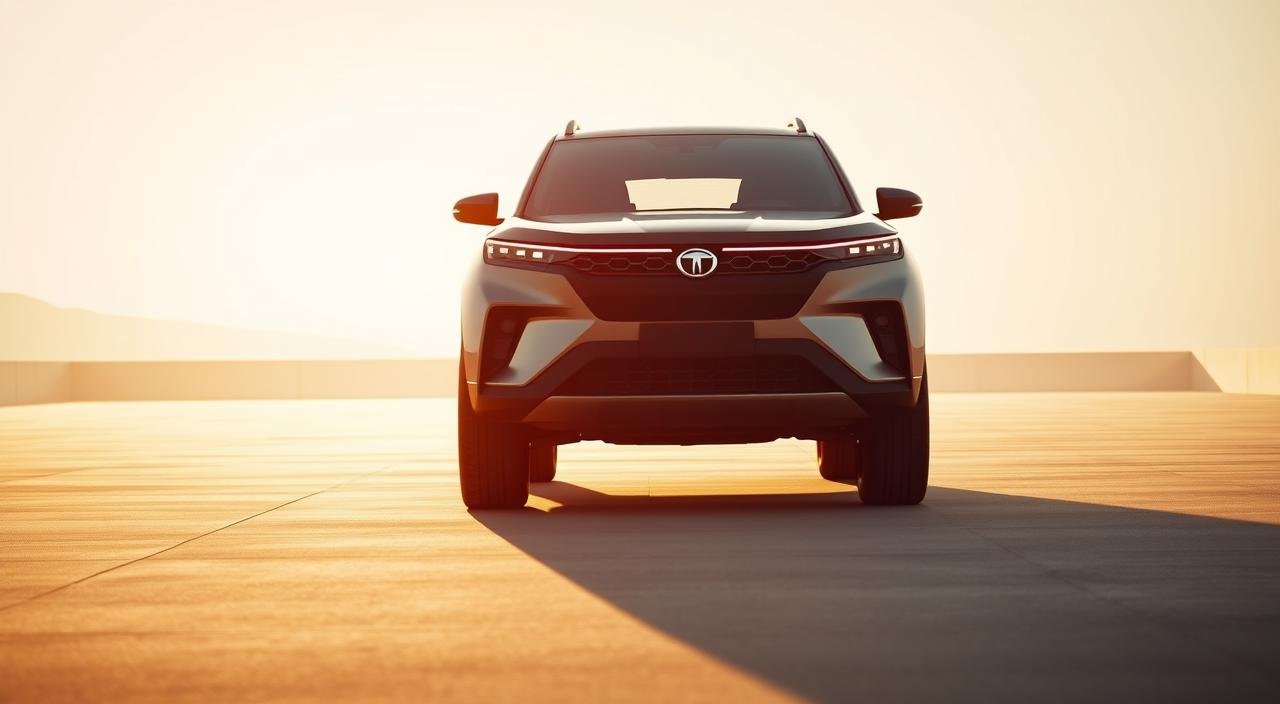
Aug
Is the Tata Harrier EV ready to change India’s electric vehicle scene? Or does it miss the mark? Tata Motors is getting ready to make its popular Harrier electric. The diesel Harrier already impresses with its 2-liter engine, giving 170 PS power and 350 Nm torque.
The Harrier is a standout in the SUV market with its big size. It’s 4,605mm long and has a 2,741mm wheelbase. Starting at Rs 18.99 lakh, it beats rivals like the Hyundai Creta in size and presence. As charging gets better and battery tech improves, the Tata Harrier EV is set to fill a big gap in India’s electric SUV market.
This analysis looks at four key upgrades for the Tata Harrier EV. These changes could make it a top choice in the electric SUV market. Each improvement tackles real concerns for Indian buyers looking for their next electric SUV.
Key Takeaways
- The Tata Harrier EV builds on a proven platform with impressive dimensions exceeding competitors
- Current diesel variants showcase strong performance with 170 PS power and 350 Nm torque
- India’s evolving EV infrastructure creates opportunities for premium electric SUVs
- Four specific improvements could elevate the Harrier EV to segment leadership
- The electric version addresses gaps in India’s premium EV market
- Competitive pricing starting at Rs 18.99 lakh positions it well against rivals
Introduction to Tata Harrier EV
The car world in India is changing fast, with electric vehicles becoming more popular. Tata Motors is ready to make its Harrier SUV electric. This review looks at why the Harrier EV is a big deal in the EV market in India.
Overview of the Tata Harrier EV
The Tata Harrier EV is a big step for the brand in the electric SUV market. It uses the same platform as the diesel Harrier but is electric. It’s for people who want a car that’s good for the planet and doesn’t lose out on comfort or space.
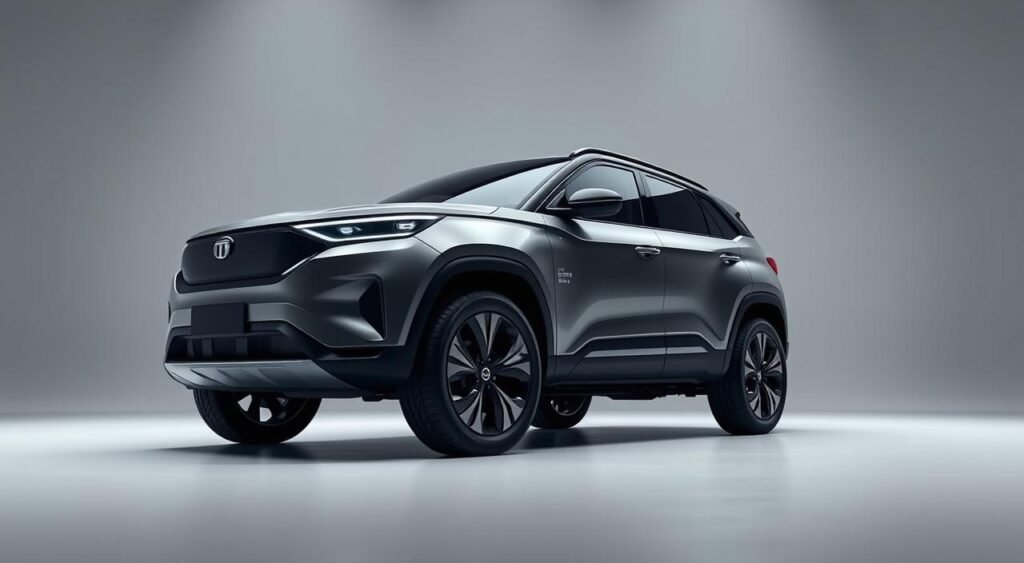
Key Features and Specifications
The Harrier EV has some amazing features:
- Auto-LED bi-projector headlights for better visibility
- Dual 10.25-inch displays for entertainment and info
- Level-2 ADAS for safer driving
- Range of 400-500km, meeting current needs
- Advanced battery system for better efficiency
Market Positioning in India
The Harrier EV is priced between Rs 18.99-20.69 lakh. It’s in a competitive market where people want good value and new ideas. The EV market in India has grown a lot, with better charging and higher range expectations. The Harrier EV meets these needs for city and highway driving.
Design and Aesthetics
The Tata Harrier EV has a bold design that mixes modern looks with SUV toughness. Its exterior styling makes it stand out on the road. The inside is all about comfort and luxury. Let’s see what makes this electric SUV special and how it could get even better.
Exterior Design Elements
The Harrier EV’s exterior is eye-catching, with blacked-out ORVMs and LED turn indicators. Its 17-inch alloy wheels are strong, and the LED taillights add a modern touch. For those who love adventure, there are roof rails for extra practicality.
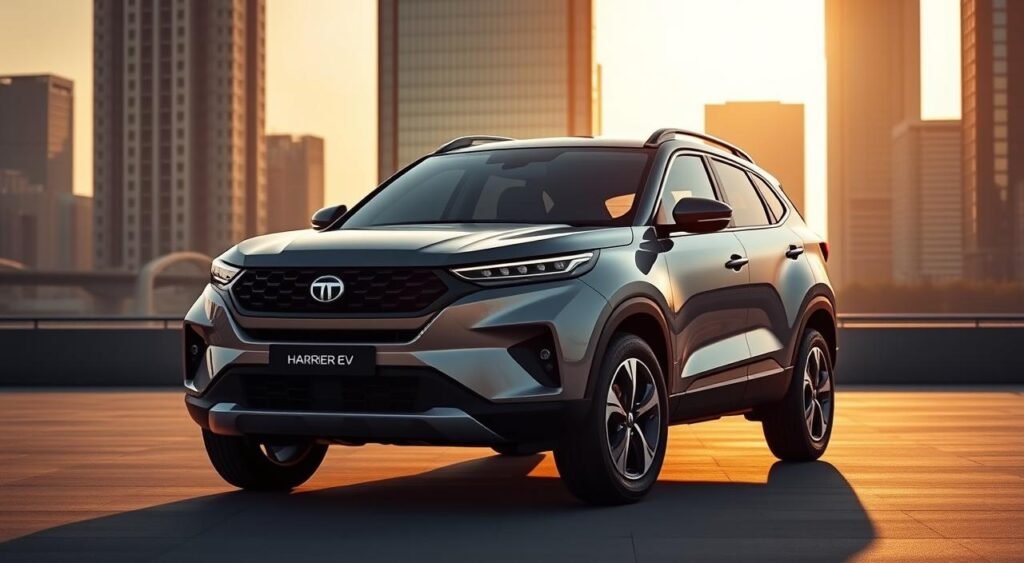
The design focuses on clean lines and being aerodynamic. The front has a closed-off grille, typical of EVs, with sharp LED headlamps. Side cladding adds protection and visual appeal to the profile.
Interior Comfort and Features
Inside, the Harrier EV impresses with black leatherette seats and tan accents. The 4-spoke steering wheel has an illuminated Tata logo, adding a touch of luxury. The two-tone cabin theme makes it welcoming.
- 6-way power-adjustable driver seat
- Spacious legroom surpassing compact SUVs
- Premium leatherette upholstery
- Illuminated brand elements
Color Options and Customization
The Harrier EV comes in several monotone colors to match different tastes. While the colors are good, more customization options could attract more buyers. Competitors like Hyundai Creta offer dual-tone alloy wheels and dynamic turn indicators, showing what’s possible for personalization.
Performance and Driving Experience
The Tata Harrier EV is a big step forward in electric cars. As cars move to electric power, it’s key to know how they drive. The Harrier EV mixes power with efficiency, making it a top choice for electric driving.
Battery Efficiency and Range
Battery tech is key for car performance. The Harrier EV’s battery is top-notch in its class. Electric cars usually get 5-10 km/kWh, depending on the battery and car setup.
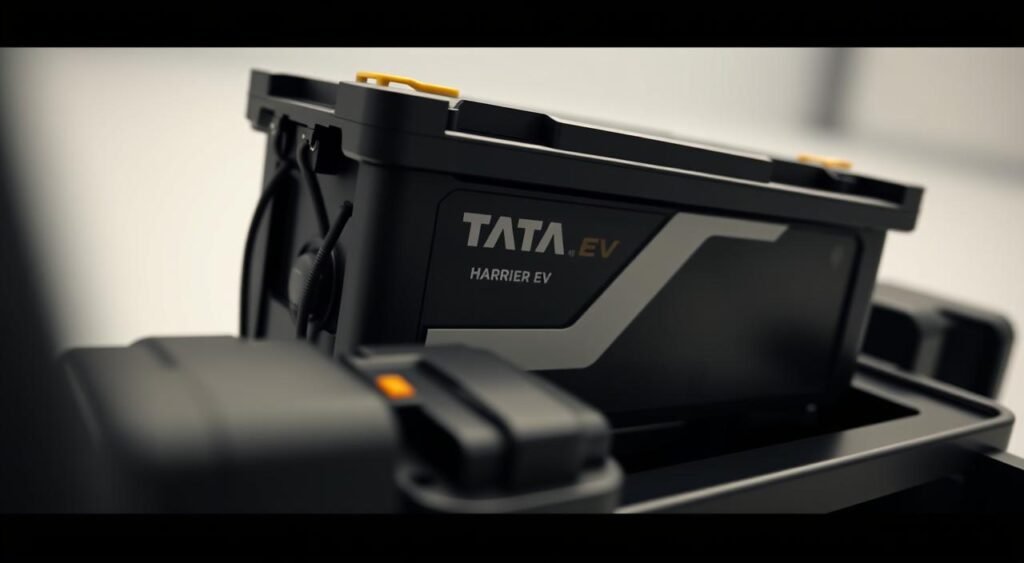
The car’s range changes with how you drive and the battery size. Cars with NMC batteries are often lighter and more efficient. Keeping the battery cool is also important for its performance, no matter the weather.
Handling and Ride Quality
The Harrier EV handles well, perfect for Indian roads. It’s comfy and stable, even when turning. You can adjust how much the car uses regenerative braking to fit your driving style.
How the car is weighted affects how it handles. Cars with the engine in the front are usually easier to handle. Special tires and wheels make the ride smoother and more efficient.
Comparisons with Other EVs
Here’s how the Harrier EV stacks up against other electric cars:
| Model | 0-100 kmph | Battery Type | Efficiency |
|---|---|---|---|
| Hyundai Creta EV | 7.5 seconds | 52kWh NMC | 8-10 km/kWh |
| Mahindra BE6 | 7.0 seconds | 79kWh LFP | 5-7 km/kWh |
These numbers show different ways electric cars are made. Efficiency analysis shows that lighter batteries use less energy, even if they’re smaller.
Technology and Features
The Tata Harrier EV is packed with modern tech to compete with other electric cars in India. It has both useful features and advanced safety systems. Yet, some areas could be better to keep up with the leaders.
Infotainment System and Connectivity
The Harrier Adventure X has wireless Apple CarPlay and Android Auto, along with a 6-speaker sound system. This setup is good for everyday music. It also has front 45W Type-C charging ports and an illuminated glovebox for easy access.
But, some rivals have better audio tech. The Hyundai Creta has an 8-speaker Bose system. The Mahindra BE6 even has a Harman Kardon Dolby Atmos setup, rivaling premium Burmester systems. These systems offer a better listening experience than the Harrier’s.
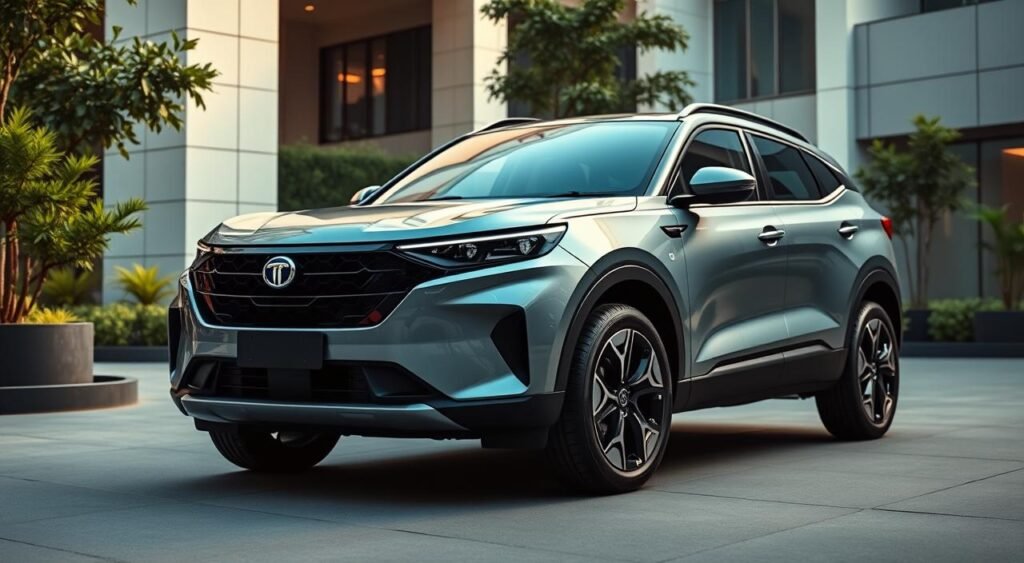
Autonomous Driving Capabilities
The Harrier EV has Level-2 ADAS for highway driving help. It includes:
- Adaptive cruise control for safe distances
- Lane keeping assist for stability
- 360-degree camera system for better visibility
- Rain-sensing wipers for weather adaptability
Some rivals have more features like autopark and blind spot monitoring with cameras. These are chances for the Harrier to improve in the future.
Safety Features and Ratings
The Harrier EV focuses on keeping passengers safe with many safety systems. It comes with 6 airbags, ISOFIX child seat mounts, and electronic stability control. The 360-degree camera system also helps with parking and tight spaces.
| Safety Feature | Tata Harrier EV | Segment Standard |
|---|---|---|
| Airbags | 6 | 6-7 |
| ADAS Level | Level 2 | Level 2 |
| 360° Camera | Yes | Yes |
| Blind Spot Monitoring | No | Available in some |
| HUD Display | No | Available in premium variants |
The Harrier’s safety meets industry standards but could be more unique. Adding features like heads-up display (HUD) and better blind spot monitoring would make it stand out more in the EV market.
Conclusion: The Path Forward for Tata Harrier EV
The Tata Harrier EV is at a turning point. The Indian electric SUV market is growing fast, with cars like MG ZS EV and Hyundai Kona Electric leading the way. To succeed, the Harrier EV must offer great value at a competitive price. It has a strong base thanks to Tata’s reputation and roomy design, but it needs to do better to win over customers.
Addressing the Shortcomings
The Harrier EV has some key areas to work on. It needs to get better mileage than 8 km/kWh to keep up with the competition. Improving the battery management system is a top priority. Tata Motors also needs to grow its EV service network in big cities.
The car’s throttle needs to be smoother, matching the quick power of electric cars. This is what buyers want.
Future Updates and Improvements
Upcoming updates will add features like ventilated seats and climate control. Wireless charging will also be added. The goal is to make the Harrier EV fast, accelerating from 0-100 kmph in under 8 seconds.
Long-distance travel is a big deal, so a range of 400+ kilometers is essential. Adding advanced safety features will make the car more appealing to tech lovers.
Final Thoughts on Market Position
The Harrier EV has a real chance to shake up the Indian electric SUV market. It has a lot going for it, like a solid feature list and a reliable platform. But, it must fix its current issues and keep its price competitive.
India’s growing EV infrastructure is a big plus for new players. With the right updates and a smart marketing strategy, the Harrier EV could become a top choice in this fast-growing field.
FAQ
When will the Tata Harrier EV launch in India?
Tata Motors hasn’t set a launch date for the Harrier EV yet. But, they’ve shown they can do it with the current Harrier. The diesel versions have cool features that could work well in an electric car as India’s EV setup gets better.
What is the expected price range for the Tata Harrier EV?
The Harrier diesel costs between Rs 18.99-20.69 lakh. EVs in the same class cost between Rs 17.99-25.72 lakh. So, the Harrier EV should be priced to compete with the Hyundai Creta EV and Mahindra BE6.
What range can we expect from the Harrier EV?
People want EVs to go 400-500km in real life. The Harrier EV should aim for 8-10 km/kWh efficiency. It might need a 50-60kWh battery pack to keep up.
How does the Harrier’s size compare to other electric SUVs?
The Harrier is bigger than the Hyundai Creta, with a length of 4,605mm and a wheelbase of 2,741mm. It has more room inside, making it a strong contender in the electric SUV market.
What advanced features does the current Harrier offer that could transfer to the EV version?
The Harrier has Level-2 ADAS, a big touchscreen, and a digital display. It also has a 360-degree camera and wireless CarPlay/Android Auto. The EV version might get even more tech, like better regenerative braking.
What improvements would the Harrier EV need to compete effectively?
To beat the competition, the Harrier EV should have ventilated seats and dual-zone climate control. It should also accelerate fast and be very efficient. Plus, it needs better battery management and smooth braking.
How does Tata’s service network compare for EV support?
Tata Motors has a big service network in India. But, they need to make sure their EV service is top-notch. They should train their techs well and have good charging support at service centers.
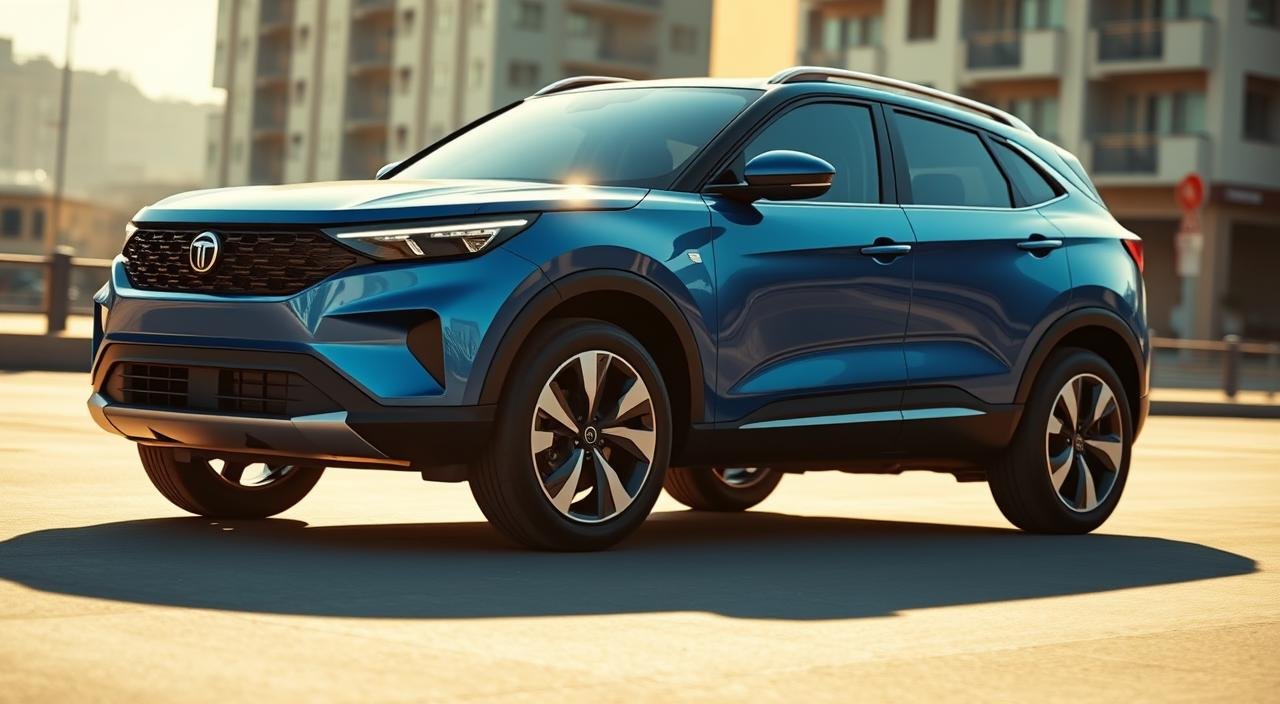
Jun
Are you ready to see the future of green cars in India? Tata Motors has unveiled the Tata Harrier EV, a game-changing electric SUV. It’s set to change the Indian car market with its advanced tech and strong performance. Let’s dive into 10 amazing images that show off the Harrier EV’s design and features.
The Tata Harrier EV starts at Rs 21.49 lakh, making it a great choice for those who care about the planet. It has two battery packs and can go up to 627 km on a single charge. You can choose from three variants and four colors, including a special Stealth Black for the Stealth Edition.
Key Takeaways:
- The Tata Harrier EV is Tata Motors’ flagship electric SUV, packed with advanced features
- Two battery pack options provide a claimed range of up to 627 km
- Available in three variants and four color options, including an exclusive Stealth Black
- Introductory ex-showroom price of Rs 21.49 lakh makes it an attractive eco-friendly option
- Set to revolutionize the Indian electric vehicle market with cutting-edge technology and performance
Overview of the Tata Harrier EV
The Tata Harrier EV is a game-changing electric vehicle. It combines the latest technology with a sleek design. Built on Tata’s advanced Acti.ev platform, it offers an unmatched driving experience. This SUV shows Tata’s dedication to innovation in electric vehicles.
What Makes the Tata Harrier EV Unique?
The Tata Harrier EV stands out with its unique features. Its design is both familiar and futuristic. It keeps the iconic SUV look but adds modern touches like a sealed-off grille and blue accents.
It also has smart features for better convenience and functionality. These include:
- Vehicle-to-Load (V2L) capability, allowing you to power external devices
- Vehicle-to-Vehicle (V2V) charging for sharing power with other EVs
- Innovative ‘Summon Mode’ for remote parking and retrieval
Key Features and Innovations
The Tata Harrier EV is powered by cutting-edge electric technology. Its high-capacity battery and efficient motors offer great range and performance. Fast charging makes it easy to recharge.
Inside, the Harrier EV is spacious and tech-savvy. The infotainment system and digital cluster make for a smooth experience. Premium materials and design elements make the interior luxurious and comfy.
Exterior Design Highlights
The Tata Harrier EV has a stunning exterior design. It combines bold looks with smooth aerodynamics. The front of this electric SUV grabs your attention with its striking features.
Eye-Catching Front Grille and Headlights
The Harrier EV’s front grille has a unique design with sleek lines. It proudly shows off the Tata logo in the center. The LED headlights, shaped like triangles, add an aggressive look.
Below, a wide air intake with vertical slats looks good and helps cool the vehicle.
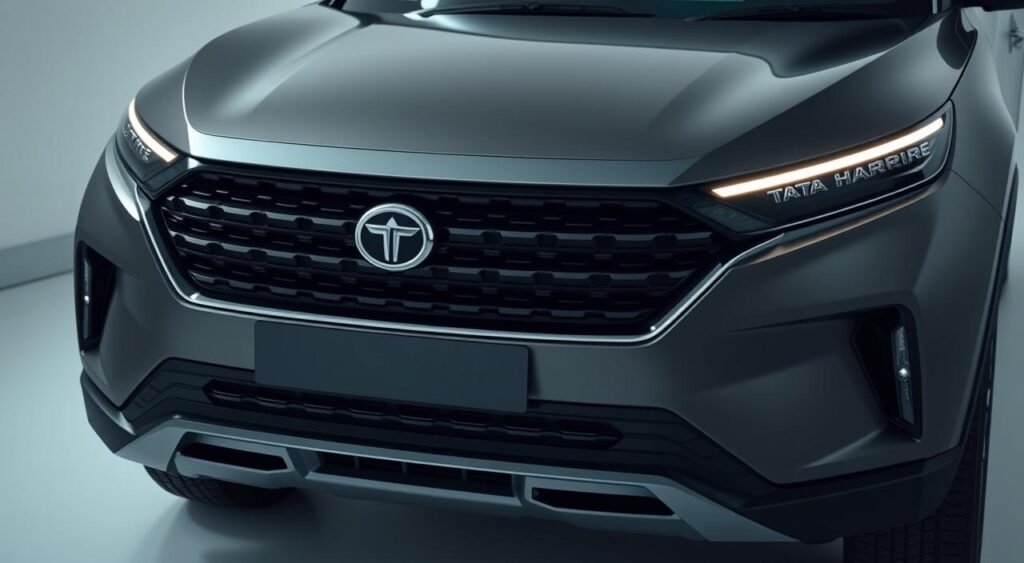
Sleek Body Lines and Stance
From the side, the Harrier EV looks similar to its gas-powered version. Its body lines show strength and athleticism. Black body cladding adds a rugged look and protects against minor damage.
The 19-inch dual-tone alloy wheels make the SUV look even more powerful. Subtle EV badging shows it’s an eco-friendly car.
Color Options and Finishes
Tata offers the Harrier EV in four exciting colors. This lets customers pick a color that matches their style. For a unique look, there’s a special matte Stealth Black edition.
Interior Comfort and Technology
When you enter the Tata Harrier EV, you’ll find a roomy and stylish interior. It features a dual-tone color scheme of white and grey, with premium leatherette seats. The SUV offers power-adjustable and ventilated front seats, a boss mode for the co-passenger, and rear AC vents for the best climate control.
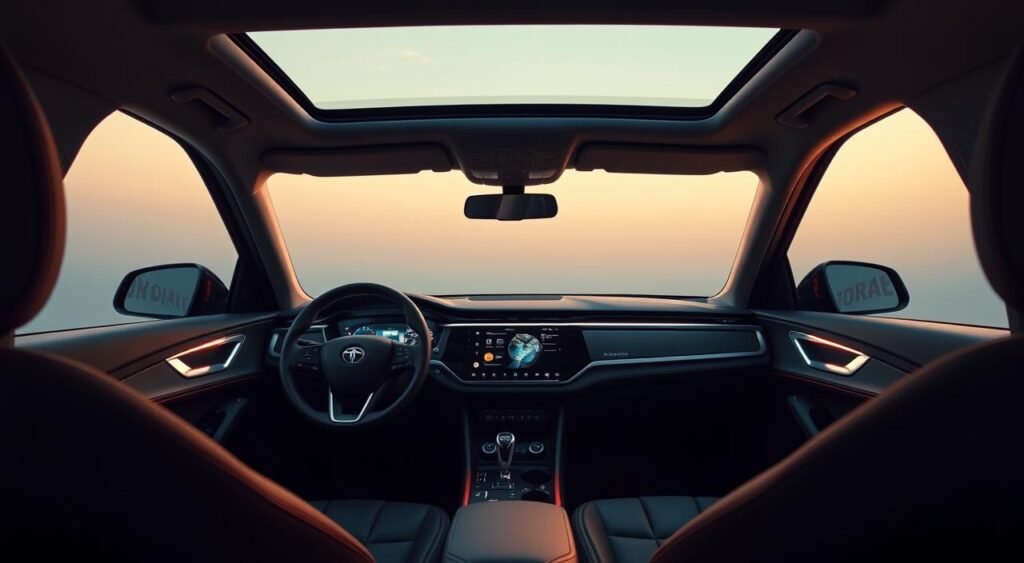
Spacious Cabin Layout
The Tata Harrier EV’s interior is designed for comfort and space. It has plenty of legroom and headroom for everyone, making long trips comfortable. The seats are ergonomically designed and adjustable, adding to the comfort.
Infotainment System Features
The heart of the Tata Harrier EV’s tech is its 14.5-inch QLED touchscreen. It controls navigation, media, and vehicle settings. The system also includes a 10.25-inch digital driver’s display for quick info access. You’ll find dual-zone climate control and a 10-speaker JBL audio system for great sound.
Safety Features Available
The Tata Harrier EV focuses on safety with many advanced features. It has seven airbags for protection in accidents. A 360-degree camera system makes parking easier. It also has blind spot monitoring, ESC, TPMS, and Level 2 ADAS for safer driving.
Performance Specifications
The Tata Harrier EV offers top-notch performance thanks to its advanced electric powertrain. It comes with two battery pack sizes and strong motor setups. This makes for an exciting drive.
Electric Powertrain Overview
The Harrier EV has a 65 kWh or 75 kWh battery pack. The rear-wheel drive version has 238 PS. The all-wheel drive version has 390 PS and 504 Nm of torque.
When Boost Mode is on, the AWD Harrier EV goes from 0 to 100 kmph in 6.3 seconds. This gives a thrilling boost of power.
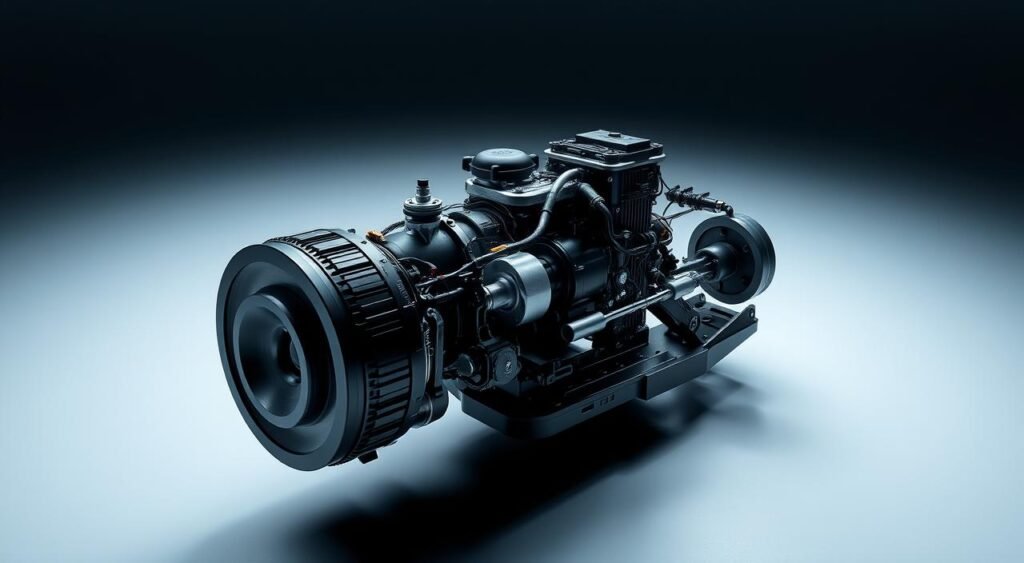
Range and Charge Time
The 75 kWh battery pack gives the Harrier EV a range of up to 627 km. This means you can go on long trips without needing to charge often. It supports both AC and DC fast charging.
| Charging Type | Charging Power | Charging Speed |
|---|---|---|
| AC Charging | 3.3 kW / 7.2 kW | 8-10 hours (0-100%) |
| DC Fast Charging | 120 kW | 25 minutes (20-80%) 15 minutes (up to 250 km range) |
Driving Experience and Handling
The Tata Harrier EV offers a smooth drive with instant torque. Its low center of gravity makes it stable and easy to handle. The regenerative braking system also boosts energy efficiency and allows for single-pedal driving.
With its strong performance, long range, and quick charging, the Tata Harrier EV is a top choice. It offers an exciting and eco-friendly driving experience.
Sustainability Initiatives
The Tata Harrier EV is a big step for Tata Motors in going green. It’s an electric car that helps cut down on carbon emissions. It shows Tata Motors’ dedication to making eco-friendly cars.
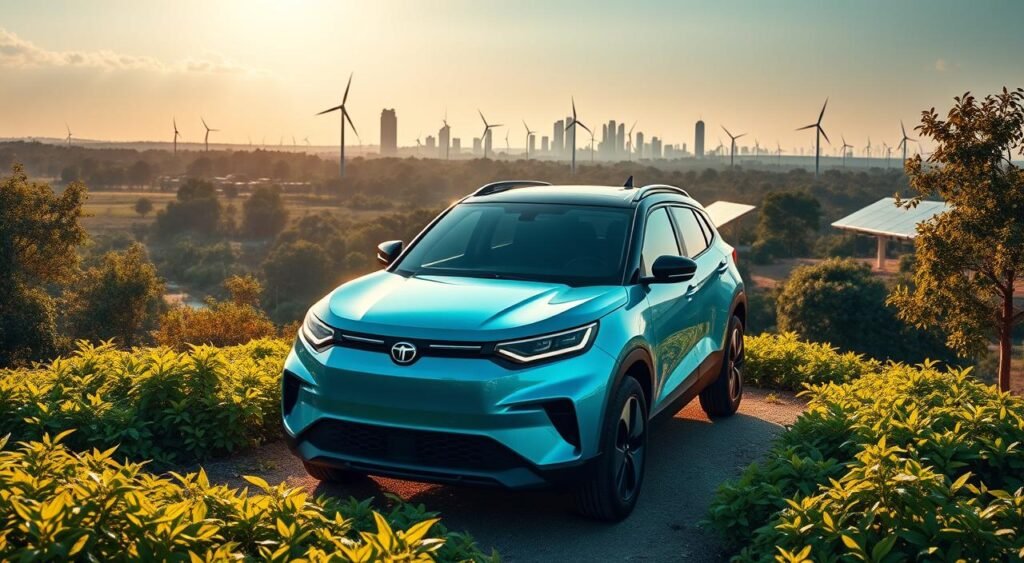
The Harrier EV uses materials that are good for the planet. Tata Motors picked these materials to be both green and strong. They use recycled and sustainable stuff to cut down on waste and save resources.
Eco-Friendly Materials Used
The Tata Harrier EV has many green materials inside and out. These include:
- Recycled plastics in the dashboard, door panels, and trim
- Sustainable fabric upholstery from recycled stuff
- Bio-based plastics from plant oils
- Lightweight aluminum and steel to make it more efficient
Tata’s Commitment to Green Energy
Tata Motors goes beyond just using green materials. They also focus on green energy for the Harrier EV’s whole life. This includes:
| Initiative | Description |
|---|---|
| Renewable Energy | Tata Motors is putting money into solar and wind power. They want to use less fossil fuel in making cars. |
| Charging Infrastructure | Tata is growing the number of EV charging stations in India. This makes it easier for Harrier EV owners to charge up with green energy. |
| Recycling Programs | Tata Motors has recycling plans for old car parts and batteries. This helps reduce waste and protect the environment. |
Tata Motors is making the Harrier EV a green choice for those who care about the planet. It’s a car that’s good for the environment without losing out on performance or looks.
Comparisons with Competitors
The Tata Harrier EV is set to shake up the electric SUV market. But how does it stack up against its rivals? Let’s dive into the Tata Harrier EV comparison with the Mahindra XEV 9e and the BYD Atto 3.
How the Harrier EV Stacks Up Against Rivals
The Tata Harrier EV shines with its impressive range and quick charging. The Mahindra XEV 9e has similar features. But the BYD Atto 3 leads with its longer range and faster charging.
Yet, the Harrier EV’s sleek design and roomy interior give it a comfort and style edge.
| Feature | Tata Harrier EV | Mahindra XEV 9e | BYD Atto 3 |
|---|---|---|---|
| Range (km) | 400 | 380 | 420 |
| Fast Charging Time (0-80%) | 60 min | 70 min | 50 min |
| Battery Capacity (kWh) | 60 | 55 | 60 |
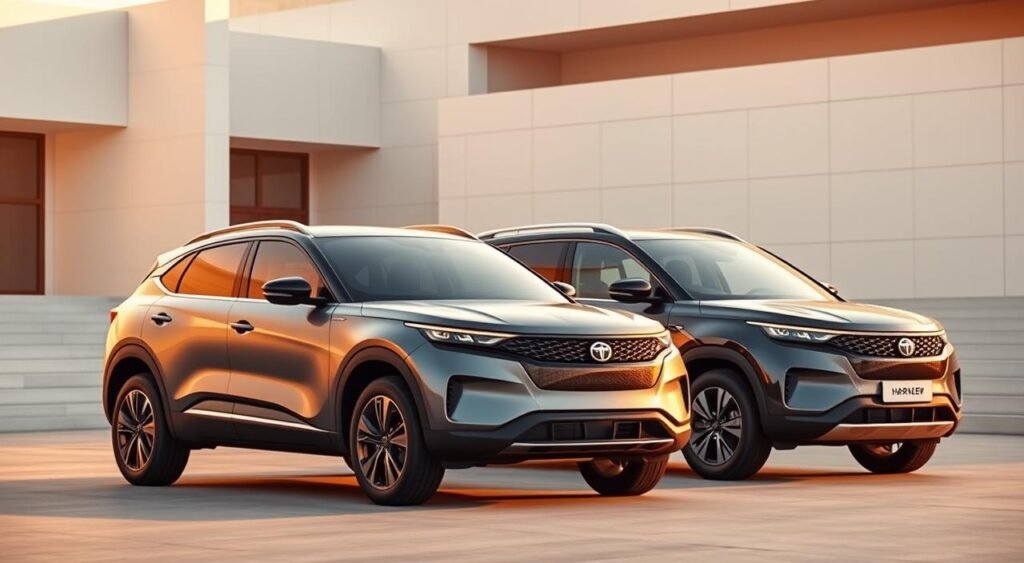
Pricing Comparison Overview
The Tata Harrier EV’s pricing is yet to be fully revealed. But it starts at Rs 21.49 lakh (ex-showroom). This makes it a competitive choice against the Mahindra XEV 9e and the BYD Atto 3.
Bookings for the Harrier EV open on July 2, 2025. This gives interested buyers a chance to be among the first to try this advanced electric SUV.
While we wait for more details, it’s clear the Tata Harrier EV is set to make a big splash. With its mix of performance, style, and price, it’s definitely worth watching for those looking at electric SUVs.
User Testimonials and Reviews
The Tata Harrier EV is making waves, with both early users and car experts sharing their thoughts. Their feedback and reviews give us a peek into what this electric SUV is like. They talk about its performance, features, and value.
Real User Experiences
Harrier EV owners love its range, design, and tech. They say it’s roomy and comfy inside, and easy to drive. People also appreciate how it handles different roads well, thanks to its suspension and electric power.
Expert Opinions on the Harrier EV
Car experts see the Tata Harrier EV as a big deal in electric SUVs. They say it’s a great mix of style, performance, and price. They like its long range, quick charging, and smart features, making it a top pick for eco-friendly buyers.
FAQ
What is the starting price of the Tata Harrier EV?
The Tata Harrier EV starts at Rs 21.49 lakh, ex-showroom.
What is the claimed range of the Tata Harrier EV?
It has two battery packs. The range is up to 627 km (MIDC).
How many variants and color options are available for the Harrier EV?
There are three variants and four colors. Plus, a special Stealth Edition in Stealth Black.
What smart features does the Harrier EV offer?
It has V2L, V2V charging, and a ‘Summon Mode’ for remote movement.
What are the interior features of the Harrier EV?
Inside, you’ll find a dual-tone cabin with leatherette seats. It has power-adjustable and ventilated front seats. There’s also a boss mode for the co-passenger seat and rear AC vents.
It comes with a 14.5-inch QLED screen, a 10.25-inch digital display, and dual-zone auto AC. Plus, a 10-speaker JBL audio system.
What are the performance specifications of the Harrier EV?
It comes with 65 kWh and 75 kWh batteries. The RWD version has 238 PS. The AWD version has up to 390 PS and 504 Nm.
It goes from 0-100 kmph in 6.3 seconds with Boost Mode. It supports 3.3 kW and 7.2 kW AC charging, and 120 kW DC fast charging.
How does the Harrier EV contribute to Tata Motors’ sustainability initiatives?
As an electric vehicle, it supports Tata’s goal to reduce environmental impact. It uses eco-friendly materials, showing Tata’s commitment to green energy.
What are the Harrier EV’s main competitors?
Its main rival is the Mahindra XEV 9e. The BYD Atto 3 is also a competitor.
When will bookings for the Harrier EV open?
Bookings start on July 2, 2025.
What are the initial user reviews and expert opinions on the Harrier EV?
Users love it for being an excellent electric car with great features at a good price. Experts praise its design, range, and smart features. They see it as a top choice in electric SUVs.
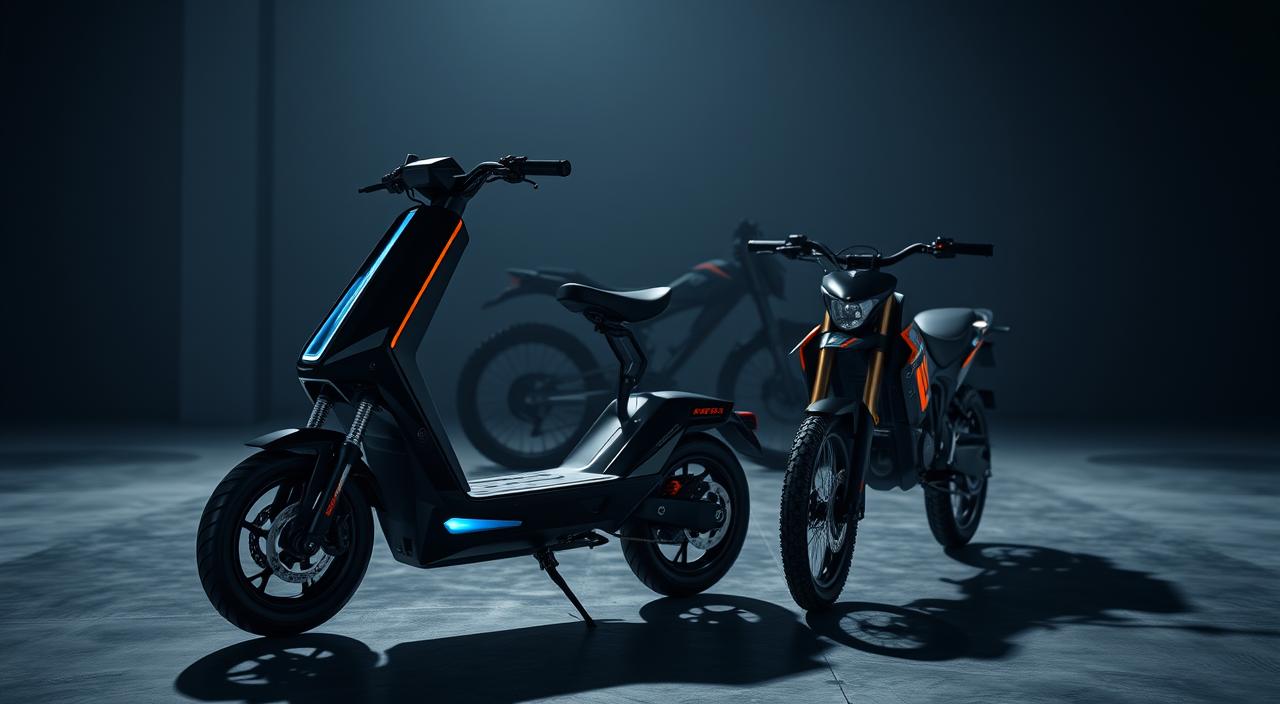
Mar
Are you ready to see the future of electric vehicles in India? Ultraviolette, a new startup in Bengaluru, has introduced two exciting products. They are the Tesseract electric scooter and the Shockwave enduro e-bike.
The Ultraviolette Tesseract scooter can go up to 261 km on a single charge. It has a 6kWh battery pack and a dynamic regen system. It can reach 125 kmph and goes from 0 to 60 kmph in just 2.9 seconds. This scooter promises an exciting ride.
The Ultraviolette Shockwave enduro e-bike is for those who love off-road adventures. It has a peak power of 14.5PS and can go 165 km on a charge. It accelerates as fast as the Tesseract, making every ride thrilling.
Key Takeaways
- Ultraviolette launches the Tesseract electric scooter and Shockwave enduro e-bike in India
- Tesseract offers a range of up to 261 km and a top speed of 125 kmph
- Shockwave delivers a peak power of 14.5PS and a range of 165 km
- Both vehicles boast an impressive 0-60 kmph acceleration time of 2.9 seconds
- Introductory prices start at Rs 1,20,000 for the Tesseract and Rs 1,49,999 for the Shockwave
Introduction to Ultraviolette Vehicles
Ultraviolette Automotive is a startup from Bengaluru changing the Indian EV market. They offer electric scooters and bikes that are fast and green. Their goal is to meet the needs of city commuters, helping India move towards electric vehicles.
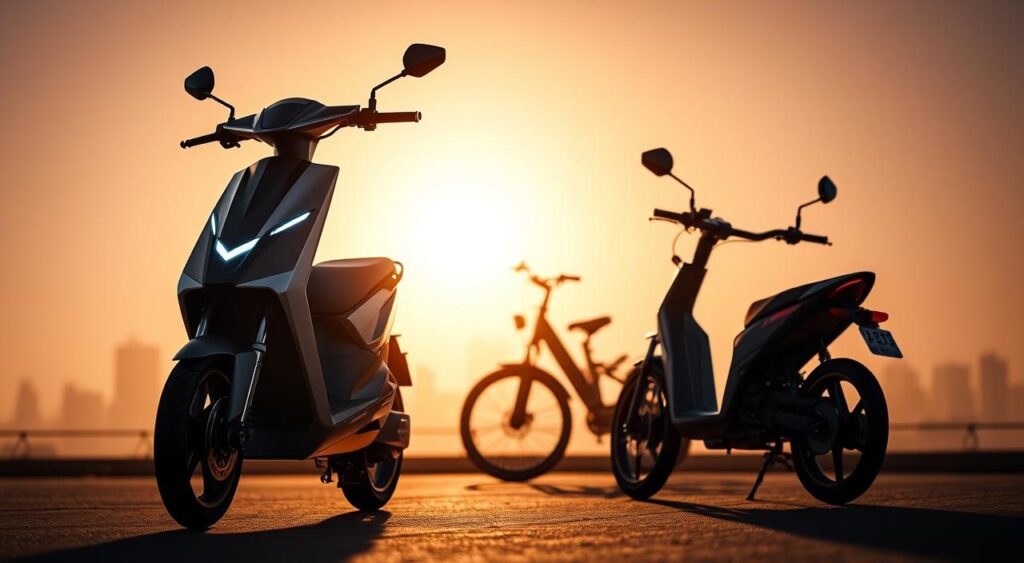
By 2028, Ultraviolette plans to introduce 10 new electric bikes and scooters. The Tesseract scooter and Shockwave motorcycle start at ₹1.45 lakh and go up to ₹1.75 lakh. This makes them affordable for many looking for green transport.
Overview of Ultraviolette
Ultraviolette Automotive wants to grow fast by entering different parts of the Indian electric two-wheeler market. They are working on five vehicle platforms:
- F Series (performance bikes)
- S Series (scooters)
- L Series (lightweight bikes)
- X Series (multi-terrain bikes)
- B Series (cruiser long-range segment)
They plan to sell 1 lakh units a year for the next three to four years. They also aim to add 12 new products to their lineup.
Mission and Vision of the Brand
Ultraviolette Automotive wants to make India’s transport greener by introducing electric vehicles. They dream of a future where electric bikes and scooters are the norm. This will help cut down on pollution and make the air cleaner.
They focus on making their products better and introducing new tech. This will make electric vehicles more appealing to everyone. Ultraviolette is set to be a big player in India’s electric vehicle market.
Discovering the Ultraviolette Tesseract Scooter
The Tesseract electric scooter from Ultraviolette is a standout in India’s e-mobility scene. It combines sleek design, impressive performance, and smart features for a smooth ride.
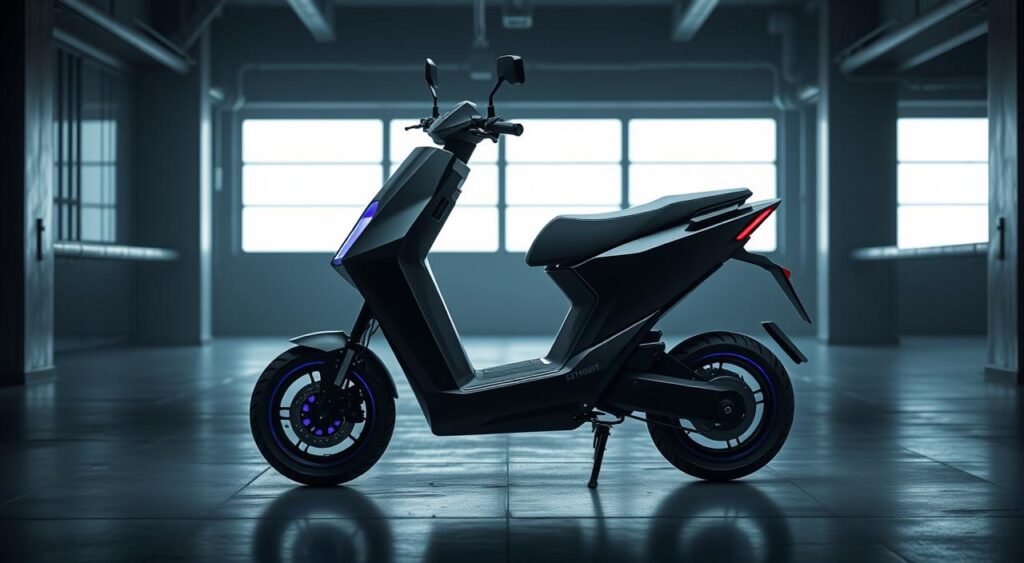
Design Features and Aesthetics
The Tesseract has a futuristic design that stands out. It features dual projector headlamps, floating DRLs, and a premium finish. The 7-inch TFT screen adds a modern touch, giving riders easy access to info and connectivity.
Performance and Specifications
The Tesseract is powered by an electric motor that produces up to 20bhp. It can hit speeds of 125 kmph, perfect for city and highway rides. With a 6kWh battery, it offers an IDC range of up to 261 km, reducing the need for frequent charging.
The Tesseract comes in three battery options to meet various needs:
- 6 kWh battery with a peak power output of 15 kW and an IDC range of 261 km
- 3.5 kWh battery with a peak power output of 10 kW and an IDC range of 162 km
- 5 kWh battery with a peak power output of 15 kW and an IDC range of 220 km
Smart Technology Integration
The Tesseract is packed with smart features. It has onboard navigation for easy route finding. Wireless phone charging keeps riders connected without battery worries. It also has advanced safety tech for peace of mind.
The Tesseract starts at Rs 1.2 lakh for the first 10,000 buyers. The price goes up to Rs 1.3 lakh for the next 50,000. The final price is Rs 1.45 lakh. You can pre-book it for Rs 999, with deliveries starting in early 2026.
The Ultraviolette Shockwave Enduro E-bike
Ultraviolette has introduced the Shockwave, a street-legal off-road e-bike. It promises an exhilarating ride on various terrains. Built on a lightweight platform, it combines cutting-edge tech with rugged durability for adventure lovers.
Key Features and Build
The Shockwave enduro e-bike has a 14.5bhp electric motor and 505Nm of torque. It has a 4kWh battery pack for a range of 165 km on a single charge. It goes from 0-60 kph in just 2.9 seconds, making for an adrenaline-pumping ride.
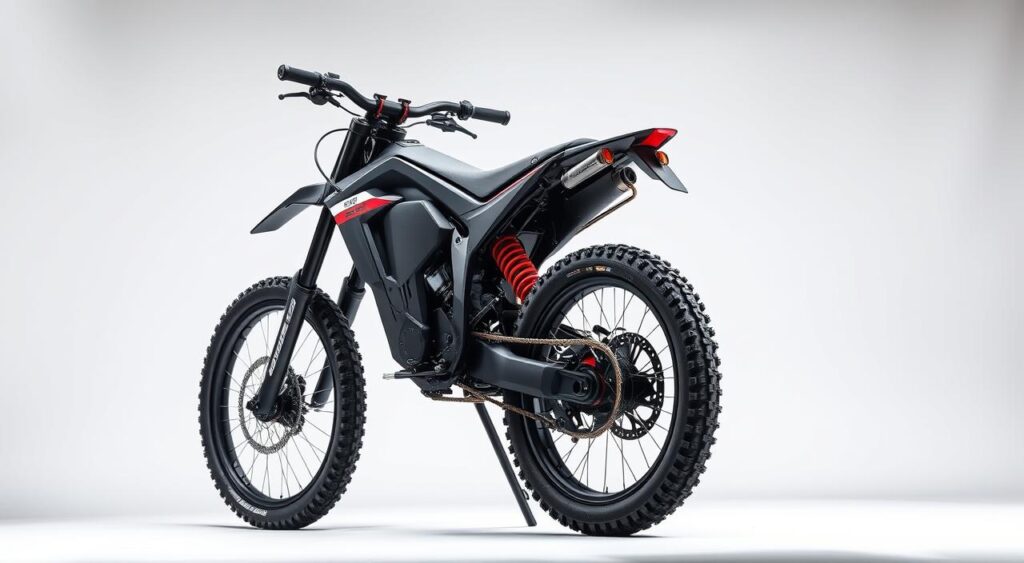
Despite its power, the Shockwave weighs only 120 kg. It has a 37mm telescopic fork and a monoshock for optimal handling and comfort on rough terrains.
Riding Experience and Comfort
The Shockwave offers a thrilling ride with responsive acceleration and smooth power delivery. It has traction control modes and dynamic regeneration for easy adaptation to different conditions. The dual-channel ABS and braking system ensure confident stopping power.
Comfort is key, with ergonomic seating and controls that reduce fatigue. The suspension setup absorbs shocks and vibrations, ensuring a plush ride on challenging trails.
Versatility for Different Terrains
The Shockwave is versatile, with dual-purpose tires for excellent grip on paved roads and loose surfaces. It’s perfect for city streets and remote off-road trails, delivering a confident and enjoyable ride.
Its off-road performance is enhanced by advanced technology features. The traction control modes and dynamic regeneration system ensure stability and control. This helps maximize battery efficiency for longer adventures.
Priced at Rs. 1.49 lakh for the first 1,000 units, the Shockwave is an attractive option for off-road enthusiasts. Bookings are open for Rs. 999, with deliveries starting in Q1 2026. It’s set to make waves in the Indian electric vehicle market.
Comparing the Tesseract Scooter and Shockwave E-bike
Ultraviolette Automotive’s Tesseract scooter and Shockwave e-bike cater to different needs. They offer unique riding experiences. Let’s compare their performance, price, and use.
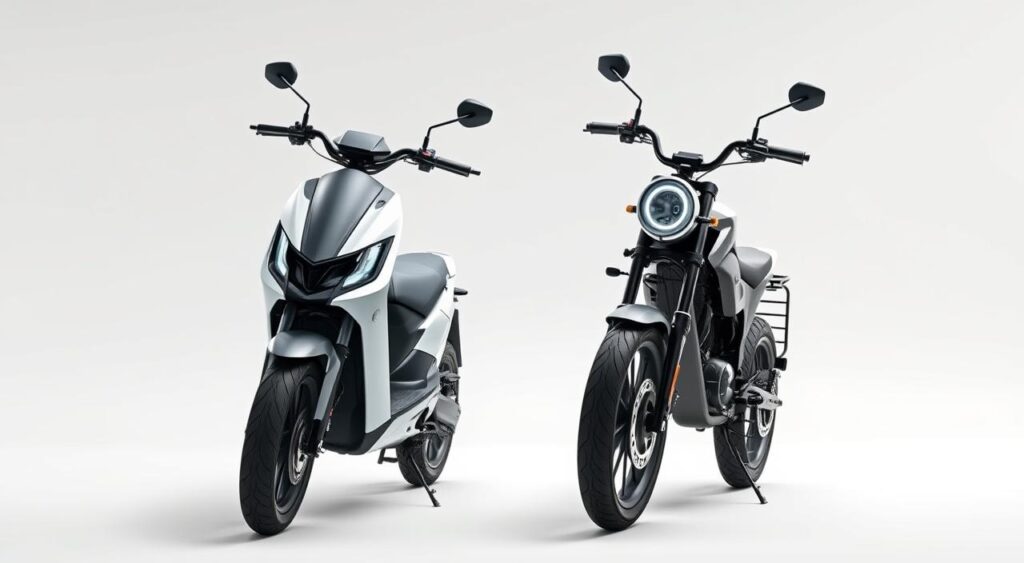
Performance Metrics
The Tesseract scooter is a powerhouse. Its top model, the Tesseract 6, has a 6 kWh battery and goes up to 261 km on a single charge. It zooms from 0 to 60 km/h in 2.9 seconds and hits 125 km/h top speed.
The Shockwave e-bike also impresses. It’s got a 10.6 kW electric motor and 505 Nm torque. It accelerates to 60 km/h in 2.9 seconds and tops out at 120 km/h.
| Performance Metric | Tesseract Scooter | Shockwave E-bike |
|---|---|---|
| Top Speed | 125 km/h | 120 km/h |
| Acceleration (0-60 km/h) | 2.9 seconds | 2.9 seconds |
| Range (IDC) | 261 km (Tesseract 6) | 165 km |
| Battery Capacity | 6 kWh (Tesseract 6) | Not specified |
Price Range and Value for Money
The Tesseract e-scooter starts at Rs 1,45,000 (ex-showroom). It’s priced at Rs 1,20,000 for the first 10,000 buyers and Rs 1,30,000 for the next 50,000. The Shockwave electric bike is launched at Rs 1,75,000 (ex-showroom). It’s priced at Rs 1,49,999 for the first 1,000 buyers.
Both vehicles offer great value. They balance performance, features, and quality well.
Target Audience and Usage
The Tesseract scooter is for urban commuters. It’s fast, feature-rich, and perfect for daily rides. It’s ideal for those who value convenience and style.
The Shockwave e-bike is for off-road lovers. It’s designed for thrilling rides on various terrains. Its powerful motor and advanced suspension make it great for outdoor adventures.
Environmental Impact and Sustainability
In the world of electric vehicles, Ultraviolette is leading the way towards sustainable transportation in India. They’ve introduced the Tesseract scooter and the Shockwave e-bike. These vehicles aim to meet the growing need for cleaner, greener options.
Ultraviolette goes beyond just making cars. They use eco-friendly methods in making their products. This includes reducing waste, using resources wisely, and using materials that can be recycled. Their goal is to lessen their impact on the environment at every step.
The Tesseract scooter and Shockwave e-bike help fight air pollution in cities. They run on electricity, not gasoline, making them a cleaner choice. By choosing these sustainable transportation options, people help make the air cleaner and reduce harmful emissions.
Eco-Friendly Manufacturing Practices
Ultraviolette is also focused on making their manufacturing green. They’ve started using practices that help the planet. Some of these include:
- Using resources wisely and cutting down on waste
- Using materials that can be recycled in their products
- Switching to renewable energy in their factories
- Improving their supply chain to cut down on emissions
Contribution to Urban Mobility Solutions
The Tesseract scooter and Shockwave e-bike are more than just vehicles. They’re part of Ultraviolette’s plan for a greener city. By making electric two-wheelers, they want to help people choose cleaner ways to get around.
These vehicles are made to fit well with city life. They have smart features and efficient batteries. This makes them a great choice for those who want to live more sustainably.
Battery Life and Charging Options
Electric vehicles rely on battery life and charging options. The Ultraviolette Tesseract scooter and Shockwave e-bike have impressive specs. They meet the needs of today’s riders.
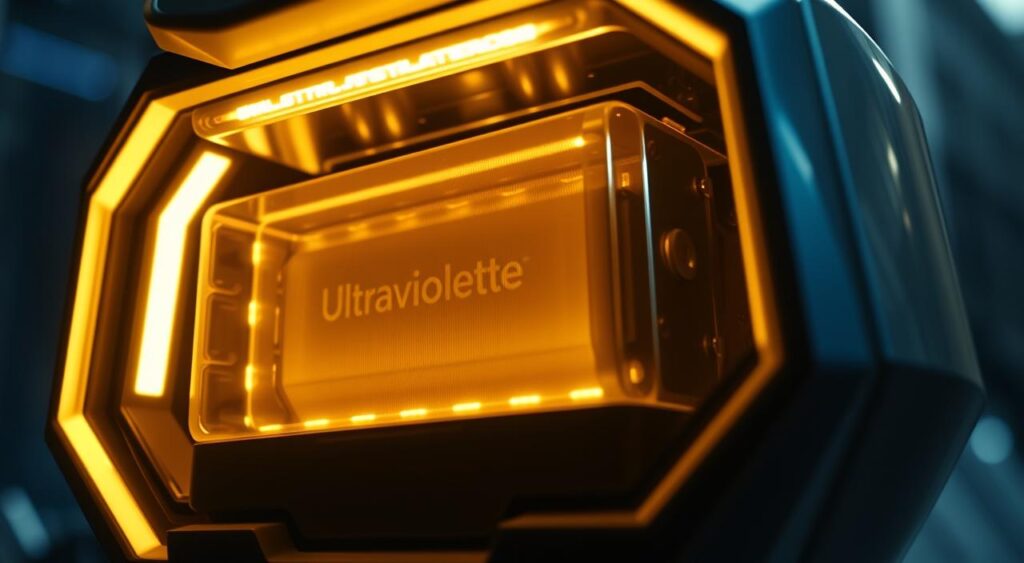
Tesseract Scooter Battery Specifications
The Ultraviolette Tesseract scooter has three battery packs. The 3.5kWh pack gives a range of 162 km. The 5kWh and 6kWh packs offer 220 km and 261 km ranges, respectively.
It can go up to 125 kmph, thanks to its 20bhp (15kW) power. Fast charging is a key feature. It charges to 80 percent in just one hour.
Ultraviolette backs the battery with an 8-year or 2 lakh kilometre warranty. This gives owners confidence in the battery’s long life and reliability.
Shockwave E-bike Battery Solutions
The Ultraviolette Shockwave e-bike has a 3.5kWh battery. It offers a range of 165 km on a single charge. It can reach 120 kmph, making it great for city and off-road rides.
| Model | Battery Capacity | Range (IDC) | Charging Time (0-80%) |
|---|---|---|---|
| Tesseract (3.5kWh) | 3.5kWh | 162 km | 1 hour |
| Tesseract (5kWh) | 5kWh | 220 km | 1 hour |
| Tesseract (6kWh) | 6kWh | 261 km | 1 hour |
| Shockwave | 3.5kWh | 165 km | – |
The Tesseract scooter and Shockwave e-bike show Ultraviolette’s focus on electric vehicles. They offer great range, fast charging, and a strong battery warranty. These features make them ideal for efficient and eco-friendly travel in India.
Safety Features of Ultraviolette Vehicles
Safety is key in electric vehicles, and Ultraviolette takes it seriously. Their Tesseract Scooter and Shockwave E-bike come with top-notch safety tech. These features give riders peace of mind on the road.
The Tesseract Scooter’s ARAS 360 full-circle radar system is a standout. It watches the surroundings in real-time, giving a full view of hazards. The radar and dashcam work together to alert riders to obstacles. The blindspot detection and lane change assist make riding safer and easier.
The Tesseract Scooter also has a combined braking system for better stopping. It recovers up to 15% of energy during braking. This makes braking smoother and safer. The anti-lock braking system (ABS) reduces skidding risk by up to 25% during emergency stops.
The Shockwave E-bike is also safe. It has a 4-star crash safety rating from Indian authorities. Its high-strength steel frame makes it 15% more rigid than other electric bikes. This gives riders confidence in its safety.
Advanced Safety Technologies
- ARAS 360 full-circle radar system
- Integrated radar and dashcam
- Blindspot detection
- Lane change assist
- Real-time collision alerts
- Combined braking system
- Regenerative braking
- Anti-lock braking system (ABS)
- High-strength steel frame
- Advanced thermal management system
User Reviews on Safety Performance
Users love the safety of Ultraviolette vehicles. They praise the collision alerts and blindspot detection. These features have helped them avoid accidents.
The lane change assist gets thumbs up too. Users feel more confident and guided when changing lanes. The advanced thermal management system is also a hit, reducing overheating risks by 30%.
Both vehicles have a minimum ground clearance of 165 mm. This is 10% higher than average electric scooters in India. Users find this extra clearance makes riding safer and more comfortable, even on rough roads.
User Experience and Community Feedback
Ultraviolette’s electric vehicles are making waves, and feedback is key. The Tesseract scooter and Shockwave e-bike are getting lots of attention. They offer unique experiences for different riders.
Testimonials from Tesseract Owners
Tesseract owners love its advanced features and fast performance. The top model can hit 60 kmph in 2.9 seconds. They also appreciate the up to 261 km range, making long trips worry-free.
The scooter’s smart tech, like the 7-inch screen and ADAS, adds to the joy of riding. Features like blind spot detection and lane change assist make it safer and more comfortable.
Feedback from Shockwave Riders
Off-road fans and adventure lovers are excited about the Shockwave e-bike. It has 505 Nm of torque and can go from 0 to 60 kmph in 2.9 seconds. Riders say it’s great for different terrains thanks to its dual-purpose tyres and adjustable suspension.
Many are happy with the Shockwave’s road-legal status and the option for a two-seater. Its 165 km range per charge is also a big plus, giving riders freedom to explore without worrying about running out of power.
| Model | Top Speed | Range | 0-60 kmph |
|---|---|---|---|
| Tesseract 6 | 125 kmph | 261 km | 2.9 seconds |
| Shockwave | 120 kmph | 165 km | 2.9 seconds |
Market Position and Competition
Ultraviolette, a Bangalore-based electric vehicle startup, is making waves in the Indian electric scooter market. It offers high-performance scooters. The company faces stiff competition from established players like Ather Energy and Ola Electric.
Ultraviolette stands out with its cutting-edge technology and advanced safety features. The company’s flagship product, the Tesseract scooter, has a range of up to 261 kilometers on a single charge. It is powered by a 20.1 bhp electric motor, enabling it to accelerate from 0-60 kmph in just 2.9 seconds.
Competitors in the Electric Scooter Market
Ultraviolette faces tough competition from Ather Energy’s 450 Apex. The 450 Apex offers a range of 157 kilometers on a full charge from its 3.7 kWh battery pack. It has a top speed of 100 kmph and can accelerate from 0-40 kmph in 2.9 seconds, priced at ₹1.99 lakh (ex-showroom).
Ola Electric’s S1 Pro+ is another formidable competitor. It is available with 4 kWh and 5.3 kWh battery packs, with a range between 242 and 320 kilometers. The S1 Pro+ has a top speed ranging from 128 to 141 kmph and can accelerate from 0-40 kmph in 2.1 seconds. The price for the Ola S1 Pro+ ranges between ₹1.43 lakh and ₹1.70 lakh (ex-showroom).
| Scooter | Battery Capacity | Range | Top Speed | 0-40 kmph | Price (ex-showroom) |
|---|---|---|---|---|---|
| Ultraviolette Tesseract | 3.5 kWh, 5 kWh, 6 kWh | Up to 261 km | – | 2.9 sec (0-60 kmph) | ₹1.20 lakh (introductory) |
| Ather 450 Apex | 3.7 kWh | 157 km | 100 kmph | 2.9 sec | ₹1.99 lakh |
| Ola S1 Pro+ | 4 kWh, 5.3 kWh | 242-320 km | 128-141 kmph | 2.1 sec | ₹1.43-1.70 lakh |
| Vida V2 Pro | 3.9 kWh | Up to 165 km | 90 kmph | 2.9 sec | ₹1.15 lakh |
| River Indie | 4 kWh | Up to 161 km | 90 kmph | 3.7 sec | ₹1.43 lakh |
How Ultraviolette Stands Out
Ultraviolette differentiates itself with unique features and a competitive advantage in performance. The Tesseract’s impressive range and quick acceleration set it apart. The company focuses on advanced safety features, including short-circuit and over-voltage protection.
Ultraviolette also offers smart connectivity features like Bluetooth and LTE connectivity, and a 5-inch TFT touchscreen display. These features appeal to tech-savvy consumers. With its cutting-edge technology and performance-oriented approach, Ultraviolette is well-positioned to capture a significant share of the growing electric scooter market in India.
Future Innovations from Ultraviolette
The electric vehicle market in India is growing fast, with a 44% CAGR from 2020 to 2025. Ultraviolette is leading the way with future EV developments. They focus on cutting-edge technology and innovative features for their upcoming models.
Upcoming Models and Features
Ultraviolette has five series for different riders:
- F Series: Includes three vehicles, the F77 Mach 2 and F77 SuperStreet
- S Series: Features the Tesseract scooter
- L Series: Showcases the Shockwave e-bike
- B Series: Will receive two vehicles in the future
- X Series: Plans to introduce three vehicles, with details to be revealed later
This variety shows Ultraviolette’s dedication to a wide range of electric two-wheelers. They aim to meet various customer needs and riding styles.
Technological Advancements in Electric Vehicles
Ultraviolette is working hard to improve electric vehicle technology. They focus on better performance, range, and user experience. Some key advancements include:
| Advancement | Impact |
|---|---|
| Improved battery technology | Longer range and faster charging times |
| Lightweight materials | Enhanced performance and efficiency |
| Advanced connectivity features | Seamless integration with smartphones and wearables |
| Over-the-air updates | Continuous improvements and new features |
Ultraviolette uses cutting-edge technologies and innovative features to lead the EV industry. They aim to capture 10% of the electric two-wheeler market in India by 2025. This puts them at the forefront of future EV development in the country.
Conclusion and Buying Considerations
Choosing the right EV depends on your needs and preferences. The Ultraviolette Tesseract scooter and Shockwave e-bike cater to different needs. If you’re looking for a stylish, efficient ride for city streets, the Tesseract might be perfect. For those who love off-road adventures, the Shockwave is the better choice.
Making the Right Choice Between Tesseract and Shockwave
Think about how you plan to use the vehicle. Consider your commute, the terrain you’ll ride on, and how fast you want to go. The Tesseract is great for city rides, while the Shockwave is perfect for rough trails. Choose based on what matters most to you.
Importance of Test Rides and Local Dealerships
Test rides are essential before buying. They let you feel how each vehicle handles. Visit your local Ultraviolette dealership to see the models up close. They can answer your questions and help with the buying process.
Choosing between the Tesseract and Shockwave depends on your personal needs. By trying them out and getting advice from dealerships, you can make a smart choice. This ensures you’ll enjoy your new electric vehicle.
FAQ
What is the range of the Ultraviolette Tesseract scooter?
The Ultraviolette Tesseract has three battery packs: 3.5kWh, 5kWh, and 6kWh. It can go 162 km, 220 km, or 261 km on a single charge, depending on the battery.
How fast can the Ultraviolette Shockwave e-bike accelerate?
The Ultraviolette Shockwave can go from 0 to 60 kmph in just 2.9 seconds. This is thanks to its strong 14.5bhp electric motor.
What are the key safety features of the Ultraviolette Tesseract scooter?
The Tesseract has many safety features. It has an ARAS 360 full-circle radar system and a dashcam. It also has blindspot detection, lane change assist, and alerts for real-time collisions.
What is the charging time for the Ultraviolette Tesseract?
The Tesseract can charge from 0 to 80 percent in just one hour. It also comes with an 8-year/2 lakh kilometre battery warranty.
How does Ultraviolette contribute to sustainable transportation?
Ultraviolette is all about sustainable transport and eco-friendly making. With the Tesseract and Shockwave, they aim to cut down carbon emissions. They want to make cities cleaner in India.
What is the price range for the Ultraviolette Tesseract and Shockwave?
The Tesseract starts at Rs. 1.2 lakh for the base model. The Shockwave costs Rs. 1.75 lakh. Both offer great value in their categories.
What makes the Ultraviolette Shockwave suitable for off-road riding?
The Shockwave is great for off-road thanks to its traction control and ABS. It also has dynamic regeneration. Its light weight and strong motor make off-road fun.
How does Ultraviolette stand out in the Indian electric scooter market?
Ultraviolette is known for its fast vehicles, safety, and tech. The Tesseract’s range and Shockwave’s off-road skills make them stand out in the market.
